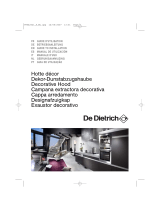32
1 / NOTICES TO THE USER
SAFETY RECOMMENDATIONS
— This oven was designed for use by private
persons in their homes.
— This appliance is not designed to be used by
people (including children) with reduced phys-
ical, sensorial or mental capacity or people
lacking in experience or knowledge, except if
they have the benefit, through the intermedi-
ary of a person responsible for their safety, of
preliminary supervision or instruction con-
cerning the use of the appliance. It is advis-
able to supervise children to make sure that
they do not treat the appliance as a toy.
— When you receive the appliance, unpack or
have it unpacked immediately. Give it an over-
all general inspection. Make note of any con-
cerns or reservations on the delivery slip and
make sure to keep a copy of this form.
— Your appliance is intended for standard
household use. Do not use it for commercial
or industrial purposes or for any other pur-
pose than that for which it was designed.
— Do not modify or attempt to modify any of
the characteristics of this appliance. This
would be dangerous to your safety.
— Repairs must only be carried out by an
approved specialist.
— Always unplug the hood before cleaning it
or performing other maintenance acts.
— Provide adequate ventilation for the room in
the case of simultaneous use of the hood and
other appliances powered by an energy
source other than electricity. This will prevent
the hood from aspirating the combustion gas-
es.
— You should never "flambé" dishes under the
hood or operate gas rings under the hood
without placing cookware on them (the flames
sucked up into the hood can damage the
appliance).
— When frying food under the appliance, you
must carefully monitor the preparation at all
times. Oils and grease brought to very high
temperatures can catch fire.
— Respect the recommended frequency of
cleaning and filter replacements. The accumu-
lation of grease deposits may cause a fire.
— The hood should never be used over a com-
bustible fuel burning stove (wood, coal, etc.).
— Never use steam or high-pressure devices
to clean your appliance (requirement imposed
by electrical safety).
— With a view to constantly improving our
products, we reserve the right to modify their
technical, functional or aesthetic characteris-
tics, making any changes to their features
considered necessary or desirable in view of
technical progress.
— In order to easily locate the reference infor-
mation for your appliance, we recommend
that you note these data on the "After-Sales
Service Department and Customer Relation
•
Attention
Keep this user guide with your appli-
ance. If the appliance is ever sold or trans-
ferred to another person, ensure that the
new owner receives the user guide. Please
become familiar with these recommenda-
tions before installing and using your appli-
ance. They were written for your safety and
the safety of others.
Warning
In the case of a kitchen heated by a
device connected to a chimney (a stove, for
example) the "recycling" version of the
hood should be installed. Do not use the
hood without metal filters.
Suitable ventilation should be provided in
the room when the hood is used at the
same time as appliances operated by gas
or another combustible fuel.
EN






















